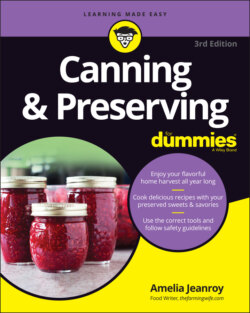Читать книгу Canning & Preserving For Dummies - Amelia Jeanroy - Страница 58
Bacteria
ОглавлениеBacteria are a large group of single-celled microorganisms. Common bacteria are staphylococcus and salmonella. Botulism, the one to be most concerned with in canning, is the most dangerous form of bacteria and can be deadly. It’s almost undetectable because it’s odorless and colorless. Botulism spores are deadly but can be easily destroyed by heating the food to an internal temperature of 180 degrees Fahrenheit (85 degrees Celsius) for at least 5 minutes. Boiling occurs at 212 degrees Fahrenheit (100 degrees Celsius) and is the safest and easiest way to protect yourself from becoming ill.
Botulism spores hate high-acid and pickled foods, but they love low-acid foods. When you provide these spores with an airless environment containing low-acid food, like a jar of green beans, the spores produce a toxin in the food that can kill anyone who eats it. The only way to destroy them in low-acid food is by pressure canning.
For safety’s sake, before eating any home-canned, low-acid food, boil it for 15 minutes from the point of boiling, if you are at an altitude of 1,000 feet or lower. For altitudes above 1,000 feet, add 1 additional minute for each 1,000 feet of elevation.
Boiling kills the botulism bacteria, but only if boiled until the food reaches an internal temperature of 180 degrees Fahrenheit for at least 5 minutes. Symptoms from ingesting botulism-infected food occur within 12 to 36 hours after eating it. These symptoms include double vision and difficulty swallowing, breathing, and speaking. Seek medical attention immediately if you believe you’ve eaten infected food. Antitoxins are available to treat this poisoning, but the sooner, the better.
No matter how long you boil your jars, they will never reach a higher temperature than that of boiling water. This is why water-bath canning and pressure canning are not interchangeable.
